Pernille Ripp's Blog, page 78
June 18, 2015
But The Kids Aren’t Reading – 20 Ideas for Creating Passionate Reading Environments

So many of us are trying to create passionate reading environments, we are doing all the things the experts tell us to do, and yet, something just isn’t clicking. Some kids are reading sure, but they would probably be reading any way, others though, not so much. Our passionate reading environments are just not working for all of our kids.
When I moved from 5th to 7th I knew I would be up against a challenge, after all, I had seen the slow decline of reading in my 5th graders and was pretty sure it would continue as they got older. And I was right, by 7th graders some of my students are not just disliking books, some really hate reading. And they are vocal about it! So what have I done to continue to create passionate reading environments? Here are a few ideas…
Invested in books. Every single book that I have in my classroom, pretty much, is a book that I think might capture a reader. When a book gets worn, I replace it. If a book has a bad cover, I try to see if a new version has come out with an updated cover. While I know our libraries should have massive amounts of books for all readers, I also believe in quality over quantity.
Diversity in books. The #WeNeedDiverseBooks movement have really gained momentum the past year, and rightfully so, and I couldn’t agree more. Our students need to be able to find themselves and their lives within the books we have. Not just across racial lines or economic lines but also in the narratives of their self-identity. These three books are doing just that for many of our students.
Easy access to our books. All of my books are in bins and they are right at their fingertips. No check out system, no asking for permission. And we need it in our classrooms, not just in the book room or in the main library. We need to have in-class libraries so that students can bookshop whenever they need to and so that they can be enticed to read.
Giving choice. Choice in seating, choice in books, choice in way of reading.
Free abandonment. Students think they need permission to abandon books for some reason and so I celebrate freely whenever I abandon a book. I ask the kids if someone wants to prove me wrong when I abandon a book and they always do. Sometimes they commiserate with me about how that book is not well-written and other times they argue that I am so wrong. What it does though is that it signals to kids that they should be selective in their reading as well, because that is the sign of a wild reader, to quote Donalyn Miller’s amazing book!
Leaving time to talk books. Too often we over-schedule our lessons and don’t leave time to just talk about what we are reading and why it is amazing. So find holes in your schedule where students can just talk books without any project attached to it.
Teacher recommendations. I start many classes with the 1 minute book recommendation sharing why I loved a book or why I bought a book. Then I place it on a ledge and walk away. I do different recommendation in all of my classes.
Student recommendations. We talk about books quite a bit, both in structured and unstructured ways. We do the 1 minute speed book dating where students face each other in two long rows and one side recommends their book in a minute, one the timer buzzes they go to the next person and recommend it to them. I leave book piles out on tables for students to browse through as they enter. These are not just new books but also some of my favorite older books that students may not have discovered. They have a “Favorite reads” book tree, where they can leave their favorite books for other students to read.
The To-Be-Read List. Students need to always have an idea of what they will be reading next so we have a paper list this year of the books we cannot wait to read. Next year, we will move to use Goodreads as a way to keep track of what we have read, offer suggestions and also have a way for our friends to see what we are reading.
It is judgment free. I am not the reading police and while I continually recommend books to students I will not stop them from reading a book, nor will I judge them based on what they are reading. Sometimes your strongest readers need a break, other times your developing readers need a challenge. Letting them figure out what they need at a particular time is incredibly empowering for students and definitely necessary.
Celebrating the re-read. I re-read picture books all of the time and often find myself gravitating toward certain books. The Poisonwood Bible is a book I have read several times, relishing the vague recollection of what happens but also discovering the text in new way each time. Too often we assume that students are re-reading because they lack inspiration, but that may not be the case. Some kids are re-reading to discover more about the text, that is true close reading.
No need for speed. Because we are reading log free, we have no need to track minutes or pages. Students read as much as they can in our independent reading time and I only ask them to write down the title. We do a 25 book challenge for all students, or higher if need be, and all students keep track of how many books they have read. Larger books count for more than one so that students are not discouraged from reading thick books, but can read whatever they want. And yes, picture books or graphic novels count as well.
Protecting independent reading time. Often our independent reading time is what we sacrifice when we have a lot to cover, and yet, this is the thing we need to protect the most. I start almost every class period with 10 minutes of independent reading and it is sacred time for us (thank you for the idea Jillian Heise!). Some times that is the only reading time students get and they need it. If we worry about whether a kid is reading outside of school pay attention to what they are reading inside this time. This is where I can help kids to find better books or help them develop their skills to pick books.
Creating enticing libraries. Kids love book stores because the books are exciting, even our most reluctant readers will pick a new book of the shelves if we display it well. So I pay very close attention to how books are displayed; I use all ledges, have a gutter hanging on the wall for picture books, and I switch out the books often. I want students to pick up the books and flip through them so I have to create opportunities for that to happen.
Creating reading role models. Students need reading role models, and not just adult ones. I love being passionate reader and it is something I showcase any chance I get in our classroom, but more importantly students need to see students who are reading role models as well. We Skype with other classes to share book recommendations, we share our favorite books on our blog, and we give students time to take on the role of role model. We need to create communities of readers where students have room to discover each other as individuals so they can learn from each other.
Let them order books. If a child says they cannot find a book they love, then I pull out a Scholastic catalog or get on Amazon and I let them choose a book. I use bonus points when I can or I buy the book myself if I need to. Sometimes simply being able to completely choose a brand new book means that a child will at least try to read the books.
Crack your hardest nut. You know that kid that really hates reading and almost flaunts it every chance they get. Spend your energy on them because often they are influencing the way their peers are thinking. So they are the ones I continually pass books to, they are the ones I am always talking books with, and they are the ones that I try to get be a reading role model if I can get them hooked.
Embrace mature books. These are the books that some of our most reluctant readers will finally pick up. The ones with the swear words, or the ones with the little bit more mature story lines. Be selective, set your standards, but don’t shield all readers from mature books. These can be “that” book for some of our kids who otherwise will never read.
Ask your students. Too often we assume that we know why students are not reading, so we never ask, but that is the very first thing we need to do. Ask your students to discuss why they hate reading and get those demons out in the open so that you can start to work with them rather than just assume you know what the problem is.
Stay passionate. There are times when we get so busy that reading was pushed to the side, yet often within our busyness is when we need to embrace our passion even more. So re-ignite your own passion, change things up, go on a mission to find the most magnificent book you have ever read so that you can hand it to students. Don’t let the outside world influence your inside passionate classroom.
Become a reading warrior. No more quiet compliance when initiatives are introduced that we know will hurt students’ love of reading, we have to band together and start speaking up for our students. Their love of reading is too sacred for us to stay silent any longer. Here is the blog post that discusses this more.
What did I miss?
I missed one of the biggest ones! Thank you Rachel Yoder!
Partner with the librarian! Whether your school has one (which every school should!) or you partner with your local librarian, bringing in another knowledgable reading adult is a sure fire way to have an even bigger impact. You are not alone in trying to create passionate reading environments, your librarian should be a trusted ally.
I am a passionate teacher in Oregon, Wisconsin, USA but originally from Denmark, who has taught 4th, 5th, and 7th grade. Proud techy geek, and mass consumer of incredible books. Creator of the Global Read Aloud Project , Co-founder of EdCamp MadWI , and believer in all children. The second edition of my first book “Passionate Learners – How to Engage and Empower Your Students” is available for pre-order now. Second book “Empowered Schools, Empowered Students – Creating Connected and Invested Learners” is out now from Corwin Press. Join our Passionate Learners community on Facebook and follow me on Twitter @PernilleRipp.
Filed under: being a teacher, being me, Passion, Reading, students


June 17, 2015
Enough…

My love of reading never had to survive my childhood. My love of reading never had to survive well-meaning teachers, at least not when I was young. When I grew up, teachers weren’t really that bothered with what we read, or how much we read every night, just that we read. That we grew. That we became better. They didn’t ask us to keep logs, to record minutes, to stick post-it notes whenever we had a thought. They didn’t tell us which box to pick from or give us a label. Instead, they gave us a book, pointed to a chair, and they told us to read. Come up for air when you are done.
Some may shudder at the lack of instruction that I was put through as a young child, after all, where was all of the teaching? And yet within this brutally simplistic approach; read, read, read and then please read some more, was an immense amount of wisdom. Kids need time to read. Kids need choice. Kids need to be allowed to self-select books and then when they are done reading they should be asked to get another book. So if we hold these truths to be self-evident, I wonder, how has so much of our reading instruction gotten so far off track?
I think we teachers are part of the problem. I think our silence while we seethe inside at the new initiatives being dictated to us means that we are now complicit in the killing of the love of reading. I think we have sat idly by for too long as others have told us that students will love reading more if we limit them further and guide them more. We have held our tongue while practices have been marched into our classrooms disguised by words like research-based, rigorous, and common-core aligned. We have held our tight smiles as so called experts sold our districts more curriculum, more things to do, more interventions, more repetitions. We have stayed silent because we were afraid of how our words would be met, and I cannot blame any of us. Standing up and speaking out is terrifying, especially if you are speaking out against something within your own district. But we cannot afford to stay silent any more. With the onslaught of more levels, more logs, more things to do with what they read all in the name of deeper understanding, we have to speak up. Reading is about time to read first. Not all of the other things. And if we are sacrificing time to read to instead teach children more strategies,, then we are truly missing the point of what we we should be doing.
So I declare myself a reading warrior, and I believe you should as well. No more reading logs to check whether kids are reading. No more levels used to stop children from self-selecting books they actually want to read. No more timed standardized tests to check for comprehension. Being a fast reader does not mean you comprehend more. No more reading projects that have nothing to do with reading. No more reading packets to produce a grade that stops students from talking about books. No more rewards; prizes, stickers, lunches with the principal. We cannot measure a great reader by how many pages a school has read, so stop publishing it. Don’t publish your test scores. Don’t publish your AR levels. Publish instead how many children have fallen in love with a book. How many recommendations have been made from student to student. Publish how many books have needed to be replaced because of worn pages. Publish that, and be proud of the teachers that dare to speak up to protect the very thing we say we hold sacred.
Be a reading warrior, because for too long we have hoped that the decisions being made are always in the best interest of a child when we know at times they are not. No child is helped when we protest in silence, when we protest in the teacher lounge, or in our homes. We have to find the courage to speak up for the very students we serve. We have to practice being brave. We have to allow students to read books that they choose, to give them time to talk about their books rather than fill out a packet, and to allow them to self-monitor how much reading they are doing and then believing them when they tell us their truth. It is time for us to stand up and speak up. It is time to take back our reading instruction and truly make it about what the kids need and not what others tell us that they need. One voice can be a whisper or a protest, we make the choice when we decide to make a difference. Are you with me?
I am a passionate teacher in Oregon, Wisconsin, USA but originally from Denmark, who has taught 4th, 5th, and 7th grade. Proud techy geek, and mass consumer of incredible books. Creator of the Global Read Aloud Project , Co-founder of EdCamp MadWI , and believer in all children. The second edition of my first book “Passionate Learners – How to Engage and Empower Your Students” is available for pre-order now. Second book “Empowered Schools, Empowered Students – Creating Connected and Invested Learners” is out now from Corwin Press. Join our Passionate Learners community on Facebook and follow me on Twitter @PernilleRipp.
Filed under: being a teacher, being me, MIEExpert15, Passion, Reading, student choice, student voice


June 15, 2015
10 Tips for Going to A Conference All By Yourself

This is the summer of a lot of firsts for me; first time going to ISTE and many other conferences, first time going to certain states like Utah, first time doing an Ignite, first time going to NerdCamp (finally!) first time getting an award, and first time doing a lot of travelling by myself. So as I have been preparing to hit the road, I figured I cannot be the only one that is traveling to conferences by themselves this summer and thus needs some help on how to make the best of it. Behold, Pernille’s 10 travel tips for going to a conference all by yourself…
Make connections beforehand. If you are on Twitter, start following the hashtag of the conference and see who else will be there. I also know there are Facebook groups for some larger conferences and I have been joining some of those, just to make connections. Even if you are not into social media, Google the conference and see what comes up. I also try to scope out what type of social event there will be available to you beforehand so that you can go and meet people. No one should have to go through a conference by themselves.
Figure out your goal. The first conference I went to I tried to do it all; go to as many sessions as possible, meet new people, make meaningful connections, check out new products! And I was exhausted. So this summer it is all about meeting people. Yes, I want to learn, yes I want to see the new products, but I am focusing in one thing rather than all of them so that I can allow myself to take a break. Don’t try to do it all, do as much as you can and be excited about how much you accomplish.
Pack what you feel the most comfortable in. I like to dress up when I present, it is a professional respect thing for me, as well as something that gives me confidence when I have to speak. Even if I am not presenting, I look pulled together but always comfortable. Very rarely do I wear heels if I can wear sandals in summer, and I always dress in layers. Who wants to be cold all day? So find out what you feel your best you in and then see if that will work for you, if you are going to meet people, make sure you feel confident when you do.
Pre-brainstorm opening questions. I can be shy at times, particularly in large groups or when people tell me they have read my blog or my books. So while this may sound stupid, and I probably shouldn’t admit to this, I purposefully go through and think up questions that I can ask any person I meet. I am, after all, traveling to connect and meet with people and want to make sure that I can spark up a conversation.
Go up to people. This is something I have had to really work on, but it is important to learn how to introduce yourself to others. I have had too many missed opportunities where I had hoped to meet someone and I never felt the right moment came for me to go up to them. Later I was bummed I had missed the opportunity because of my own fear. So make sure you create that moment, which leads me to my next point…
Practice being brave. This is something I remind myself of every time I go a new place. I love meeting new people but can have a hard time initializing a brand new connection. I have told myself I have to practice every time I travel, every time I have the chance, and meet at least 5 new people. I set a small goal so I can accomplish it but also make it big enough for me to get in the habit of going up to people. Some of the best conversations I have had has been with complete strangers that I introduced myself too. It took bravery and that is something we could all use practice in.
Print a business card. I laughed the first time someone told me this, (what does a teacher need a business card for?), and then I went to my first conference. Aha! When you meet someone new and you want to exchange information that business card becomes your new best friend. The best part was my husband’s tip of using one of the free websites where all you have to pay for is shipping. I got 250 cards for $5 and I am bringing them all.
Plan down time. While I love the learning and connecting that happens at conferences, my brain can only take so much. So don’t overbook yourself, schedule in for down time where you will sit, eat, and do whatever it is you need to do to feel like this is still a good time. Going to conferences should be a great experience, not a hassle, nor a stressor.
Bring a book (or five). Or whatever it is that lets you completely relax by yourself. I read any time I can and know I will be traveling with a lot of books. Yes, they weigh a lot but the fact that I can pull out a book at any time and escape a little bit makes a world of difference for me.
Be a nice human being. Unfortunately sometimes going to a conference means that some people forget to be nice, or completely forget to be professional. We are all busy, we all have places to be, and yes, we probably have many people we would love to be speaking to. But be nice. Be kind to the people that speak to you. Help others. Look for people who are alone or seem like they don’t know what they are doing, after all, that person may be me.
Represent. I tell my students this whenever they leave our classroom and the word carries us out into the world. Remember, you are not just there representing yourself, you are representing your entire school community and your family. I go to conferences to share the words of my students, to help them change the way education is done to kids all around the world. That is not something I take lightly and so I behave appropriately. I have heard crazy stories of conference after parties, and I certainly have no intention of becoming part of those stories.
What else would you add to those traveling to conferences by themselves?
PS: To see where I am traveling to, go here – hopefully our paths will cross this summer.
I am a passionate teacher in Oregon, Wisconsin, USA but originally from Denmark, who has taught 4th, 5th, and 7th grade. Proud techy geek, and mass consumer of incredible books. Creator of the Global Read Aloud Project , Co-founder of EdCamp MadWI , and believer in all children. The second edition of my first book “Passionate Learners – How to Engage and Empower Your Students” is available for pre-order now. Second book “Empowered Schools, Empowered Students – Creating Connected and Invested Learners” is out now from Corwin Press. Join our Passionate Learners community on Facebook and follow me on Twitter @PernilleRipp.
Filed under: aha moment, being me, conferences, PLN


June 14, 2015
Have You Heard of the Teachers Leading Teachers Conference?
Being a teacher who presents, which is a very new adventure for me, has been quite interesting to say the least. I didn’t know just how few of us there are that actually are able to go out and talk about the things that we do with our students and still stay in the classroom. In fact, I have been to a few places where there were less than a handful of teachers presenting and yet the entire conference was geared toward teachers. Hmmm… But I get it. It is hard to leave my classroom. It is hard to leave my family. Presenting and sharing the words of my students is an incredible opportunity that I am honored to get, but it is like having two full-time jobs at times. Yet, I can’t help but wish that more teacher’s voices were heard at all of the conferences that surround us.
Well, that is exactly what the founders of the Teachers Leading Teachers Conference, John T. Spencer and A.J. Juliani thought so too. But instead of wondering about it, they decided to do something about it. So what are the details of this awesome totally online conference?
The Teachers Leading Teachers Conference (from July 16th-20th) is bringing the best teacher leaders from around the world together to present and share their failures, wins, and practical strategies for teaching today’s student.
Here Is The Best Part
The entire conference in online (no travel or paying for accommodations)! Each session is available live, and as a digital copy. This format allows you to bring back the learning to your colleagues and school leaders at anytime.
It’s often difficult to explain the experience of an Edcamp or conference when someone wasn’t there, but the TLT Conference gives you access to that learning at any time. Sign-up now and take part in this first of it’s kind, online conference for teachers.
What You’ll Get As An Attendee
Over 20 Live Presentations From Top Teachers Around the World – Mine is all about empowering students, one of my very favorite things to discuss and share about.
Digital Recordings and Access to the ALL Presentations Forever – think of the wealth of knowledge you will have access to!
Certificates for work completed and each session – I love this because my district gives me PD Hour credit for conferences like this.
20+ Hours of How-To Sessions from Teachers Still Working in Schools
Bonus Resources From Our Presenters That You Can Use Right Away
Free eBooks from the Presenters and Conference Leaders
The Best Online Experience with Cisco WebX Platform
Live Q&A Before, During, and After Each Session
Sessions on STEM, Design-Thinking, Project-Based Learning, Student Blogging
Classroom Design, Robotics, 21st Century Literacy, Genius Hour, 20% Time, and Global Projects
Schools, Group Packages, and Early Bird Pricing
We are currently offering Early Bird Pricing from now till June 16th. You’ll save $50 on each conference ticket with the early bird price. And if you use the coupon code “Pernille” you will save an additional 10%!!!!!
We are also offering group packages for schools and districts. If you are a school district leader who is interested in purchasing a school/group package please contact me at ajjuliani[at]gmail[dot]com.
Learn more about this conference at TLTconference.com – and we’d also love for you to send in a proposal to speak (on the website we have a Call for Proposals).
So I hope you consider being a part of the conference or even presenting at it. I did my very first presentation 5 years ago at an online conference and I can tell you; it is an incredible experience to share the work of your students with others!
I am a passionate teacher in Oregon, Wisconsin, USA but originally from Denmark, who has taught 4th, 5th, and 7th grade. Proud techy geek, and mass consumer of incredible books. Creator of the Global Read Aloud Project , Co-founder of EdCamp MadWI , and believer in all children. The second edition of my first book “Passionate Learners – How to Engage and Empower Your Students” is available for pre-order now. Second book “Empowered Schools, Empowered Students – Creating Connected and Invested Learners” is out now from Corwin Press. Join our Passionate Learners community on Facebook and follow me on Twitter @PernilleRipp.
Filed under: being a teacher, PLN, student voice


June 12, 2015
10 + 1 Picture Books that Spark Creativity
It is well-known that picture books are my favorite secret weapon when it comes to teaching pretty much anything. Within the pages of these incredible books we can find the courage to be better, to be friends, and to be creative. While there are many to choose from, here are my 10 favorite picture books to inspire more creativity for us and for students.
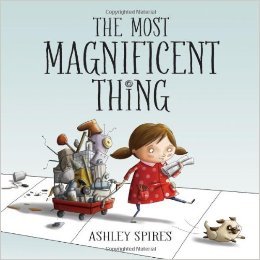
The Most Magnificent Thing by Ashley Spires continues to be a crowd favorite in my classroom. I love when students pick out the details that are in the illustration and we refer to it often when we create ourselves. Leave this book and watch conversations unfold.

Something Extraordinary by Ben Clanton arrived in my mailbox today and is actually the book that inspired this post. As I read it with Thea, my oldest daughter, I saw her eagerly turn the pages to see what would happen and then declared that she wished for many things as well. What a marvelous book to inspire a more creative world.

Peter H. Reynolds is a creative genius and his books provide me with that needed starting point to have many conversations with my students. While his more famous book The Dot is more often the one highlighted and read to students, I have found that Sky Color should have its rightful place next to The Dot.
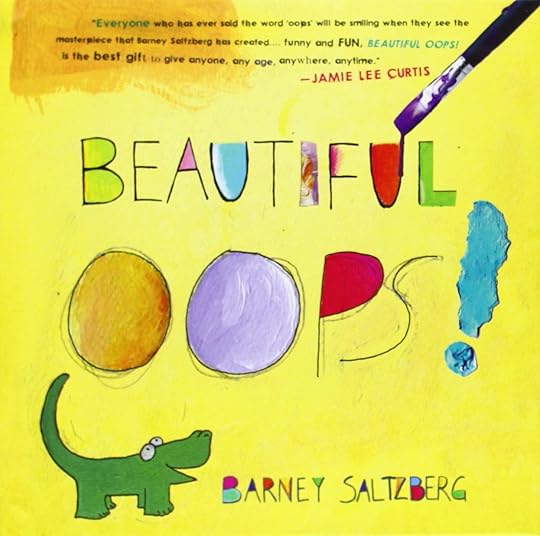
On my daughter’s 6th birthday she was gifted Beautiful Oops by Barney Saltzberg. I took one look at it and then bought a copy for my classroom. Students are so quick to dismiss their own mistakes, but this book with its simple show of what you can do with those “oops” is sure to inspire a moment to re-thing and re-draw before a supposed mistake is discarded.

I am sure I was not the only one jumping up and down when the Caldecott award was announced this year and The Adventures of Beekle – The Unimaginary Friend was the big winner. I have cherished this book in the classroom for its simple message about imagination and taking control of ones own destiny. The illustrations are divine in the book and have inspired many students to draw their own imaginary friends.

I love the giggles that students, yes even 7th graders, get whenever I read aloud Froodle by Antoinette Portis. The message to embrace their uniqueness and let their true personality shine is not one that is lost on them.
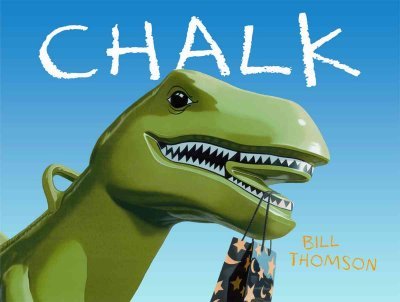
Oh Chalk by Bill Thomson, I adore thee. This inspiring wordless picture book has been inspiring my students to let their imagination run wild. It is a great book to inspire realistic fantasy stories (I may have just made up that term) where students base a fantasy story in their own world.
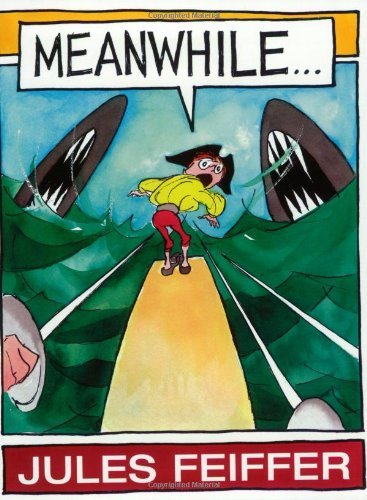
I have used Meanwhile by Jules Feiffer for a few years to inspire creative writing in my classroom. Students love the fast+paced action and the way it reads like a graphic novel. It may technically not be a picture book, but it is a book with pictures and it deserves to be on this list.

What Do You Do With An Idea by Kobi Yamada has been a great read aloud in our classroom, but more importantly, I have seen kids reach for it when they are stuck and not quite sure what to do. I think sometimes simply being able to find yourself within the pages of a book is a powerful thing for a person. And especially if you are not quite sure to ask someone else fpr help just yet.

Thea and I were lucky enough to attend an author reading of Open This Little Book by Jesse Klausmeier and that afternoon Thea asked me to make her a little book for her writing. The simple ingenuity of the story within the story has inspired many of my students to create, bith in writing but also in what they read,
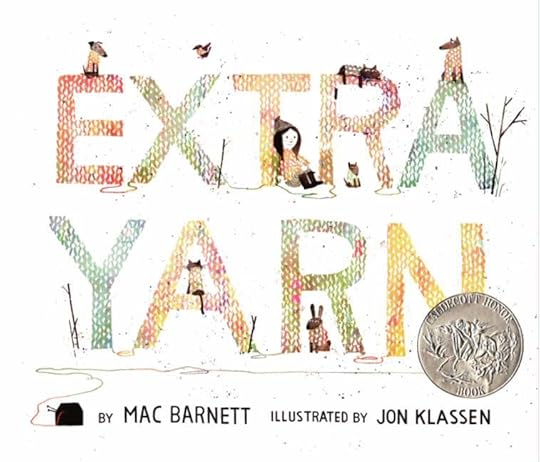
My plus one has to be Extra Yarn by Mac Barnett. I have loved using this book to discuss theme with students but I also love how it shows that you can take something simple that you can do and turn it into something extraordinary. Often this is the biggest aha moment that students get from this book.
So there you have it, a few picture books to spark creativity in the classroom. Which would you add?
PS: Some times great minds think alike, check out John T. Spencer’s post on his Favorite Fifty Books on Creativity.
I have loved seeing the suggestions roll in from Twitter as well, so I have added them as they come in:


Not a Box and Not a Stick by Antoinette Portis – yes, the same author that brought us Froodle.
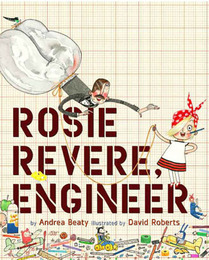

Rosie Revere Engineer and Iggy Peck Architect by Andrea Beaty
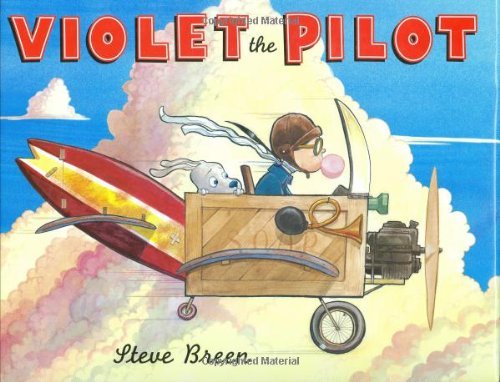
Violet the Pilot by Steve Breen.
I am a passionate teacher in Oregon, Wisconsin, USA but originally from Denmark, who has taught 4th, 5th, and 7th grade. Proud techy geek, and mass consumer of incredible books. Creator of the Global Read Aloud Project , Co-founder of EdCamp MadWI , and believer in all children. The second edition of my first book “Passionate Learners – How to Engage and Empower Your Students” is available for pre-order now. Second book “Empowered Schools, Empowered Students – Creating Connected and Invested Learners” is out now from Corwin Press. Join our Passionate Learners community on Facebook and follow me on Twitter @PernilleRipp.
Filed under: being me, books, inspiration, Passion, Reading, students


Before You Hand Out Those Rewards – 4 Questions to Ask Yourself

I have been reward and punishment free for 5 years in my classroom. I have loved it and yet rewards seem to still crop up every year, typically through school-wide initiatives or team decisions. Because I try to be a team player, I go with it as much as I can, and yet, the voice inside of me still screams that for most students, extrinsic rewards do not help. Sure there are a few kids who may become more motivated because of a reward, but I have yet to see a child really change their behavior because of an extrinsic reward system. So if you are not quite sure whether to give up rewards or not, please ask yourself the following questions.
1. Will the rewards only go to certain kids?
Rewards have always, in my opinion, been the surest way to create a divided community within a classroom. A community where there are those that get and those that don’t. I really tried to make sure that all of my students had lunch with me, which was one of the rewards they could earn, and yet there were always kids that didn’t make it, at least not legitimately. Those kids that seemed to slip through the cracks when I was handing out points, or tickets, or money or whatever it was I was handing out, and not because they weren’t well-behaved, but because they were quiet, that child that seems to slide through our day and does ok on everything, they tended to not get the rewards because of their middle of the road-ness. I tried keeping track but that created more work. And the kids that typically were misbehaved, well, I had to go out of my way to make sure they were rewarded too but they were rewarded for things like doing some work or staying in the classroom. I remember how other students felt about those types of rewards being handed out and that inherent feeling of it being unfair. In the end, handing out individual rewards did little to create a deep community and so it was easy for me to give it up.
2. Have you seen long-term changes as a result of giving extrinsic rewards?
I haven’t. I have seen students willing to do something in the short-term to earn that thing they want but I have never seen long-lasting changes, unless the reward was increased over time. So while the child’s behavior changed a small amount, the reward grew significantly until we couldn’t increase it anymore. Then the child typically reverted to their old ways or even got worse. I think when we spend more n a child earning something rather than the relationship we are building, then we are investing our time poorly.
3. Will the rewards increase or devalue the learning?
I have found that when we tie anything academically into rewards, that becomes the focus, not the learning or the growth that students have shown. When we reward students when they do their homework, do well on a test, or complete a project, we are telling them that the learning they just did is not the main focus but the completion of something is. We are also telling them that they must get something tangible whenever they finish something, which is not at all the reality of our world. When we tie in rewards with learning we can create a cycle of “Gimme” which should not be our intention as teachers.
4. Will students actually care?
Most of my students didn’t care one bit about the rewards that were handed out. They shrugged when I handed them a ticket to pick a prize, or left the prize at school, some even traded their token cash away. I remember being angry when I saw the prizes left behind, but later realized that because it was just another small thing, it didn’t mean anything to them. And why should it? Most of our students are bombarded with trinkets and disposable things wherever they go.
What did matter to my students was the time we spent together and what we did during that time. Not what reward they would get from me. So I gave up rewarding the individual students and started celebrating more with the whole class. I gave out more compliments. I had more individual conversations to talk about behavior. I started noticing more of what my kids needed and tried to give them that, rather than just dole out punishment or hand out a reward.
For me giving up rewards (and punishment) was one of the best decisions I made. Students don’t expect something other than learning when we are together, they don’t have the same sense of entitlement I saw at times, and they don’t have the threat of not being rewarded hanging over their head. Bottom-line; giving up individual extrinsic rewards meant that I could focus on the child in front of me, rather than the systems I had in place. What do you think?
To read more about my journey away from awards and punishment, click here
I also highly recommend reading Alfie Kohn’s book 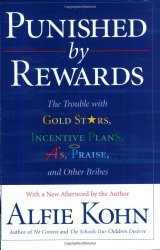

I am a passionate teacher in Oregon, Wisconsin, USA but originally from Denmark, who has taught 4th, 5th, and 7th grade. Proud techy geek, and mass consumer of incredible books. Creator of the Global Read Aloud Project , Co-founder of EdCamp MadWI , and believer in all children. The second edition of my first book “Passionate Learners – How to Engage and Empower Your Students” is available for pre-order now. Second book “Empowered Schools, Empowered Students – Creating Connected and Invested Learners” is out now from Corwin Press. Join our Passionate Learners community on Facebook and follow me on Twitter @PernilleRipp.
Filed under: aha moment, classroom management, rewards, students


June 11, 2015
Summer Literacy Academy For Teachers in Wisconsin
I am proud to be a part of a district that takes their literacy training very serious and also taps into their own experts, while focusing on what is best for all kids. Since this is open to the public but has not been advertised much, I thought I would use my blog to offer more people this opportunity because I think it is going to be amazing and is one of the cheapest professional development opportunities I have seen in a long while. As part of working for the district, I do get to be the keynote speaker for it and also head a few of the training sessions.
Oregon School District Summer Academy – June 17-19, 2015
The Academy, co-sponsored by CESA 2, focuses on literacy best practice and current hot topics within English language arts. The Academy will kick off with keynote speaker Pernille Ripp, OSD teacher and author of Passionate Learners: How to Engage and Empower Your Students. Oregon District staff, CESA 5 Literacy Consultant Heidi Walter and the Cooperative Children’s Book Center are just some of the experts that will be presenting a variety of sessions in the areas of reading, writing, speaking, and listening.
Need course credit? Registrants of Friday’s full day option “Need a Writing Intervention for RTI? SRSD to the Rescue” presented by Heidi Walters may be eligible for 1 graduate credit through Edgewood College (1 credit/$165). Registration is $25 for a single day or $50 for two or more days. To review session options and register please use the links below. We hope you will join us, be engaged and leave with a passion to put what you learn into practice!
For more information on Sessions: https://docs.google.com/document/d/1GaSiu6Mz-_YweqTk3oF7K9kHC9jcyv0KukR1amnrEyM/edit?usp=sharing
To Register: https://docs.google.com/a/oregonsd.net/forms/d/1H8DFbcdJpiR8f7YrgeLZMU-lUKRrq9szOZPlye0hvzE/viewform
All Questions to Oregon School District Contact:
Sheryl Helmkamp | sah@oregonsd.net | (608) 835-4007
Filed under: being me, Passion, PD, Reading


Some Favorite Reads From The Year
Cross-posted from my reading review blog, Mrs. Ripp Reads.
I read 80 books this school year. A goal I was not sure I would meet, and yet with two days to go, I have started my 81st book and am feeling pretty good. But that doesn’t mean I am done reading, no way! My massive to-be-read pile is practically screaming at me to start. But before I fall in love with some new books, how about a sampling of a few books I loved this year?
All of the summaries have been taken from Goodreads, by the way.

My opinion:
Red Queen is amazing, couldn’t put it down even if drew a lot of resemblance to many other amazing books. I cannot wait for the 2nd book to come out. And I cannot wait to hand this to as many students as I possibly can!
Age Range: 5th grade and up.
Summary:
The poverty stricken Reds are commoners, living under the rule of the Silvers, elite warriors with god-like powers.
To Mare Barrow, a 17-year-old Red girl from The Stilts, it looks like nothing will ever change.
Mare finds herself working in the Silver Palace, at the centre of
those she hates the most. She quickly discovers that, despite her red blood, she possesses a deadly power of her own. One that threatens to destroy Silver control.
But power is a dangerous game. And in this world divided by blood, who will win?

My Opinion: A student recommended Paper Towns to me and I read it over two nights. I, of course, wanted to see what happened, but also enjoyed the memory of what it meant to be 18 and graduating with life awaiting.
Age Range: 7th grade and up with some mature language and high school scenes.
Summary:
Quentin Jacobsen has spent a lifetime loving the magnificently adventurous Margo Roth Spiegelman from afar. So when she cracks open a window and climbs into his life—dressed like a ninja and summoning him for an ingenious campaign of revenge—he follows. After their all-nighter ends, and a new day breaks, Q arrives at school to discover that Margo, always an enigma, has now become a mystery. But Q soon learns that there are clues—and they’re for him. Urged down a disconnected path, the closer he gets, the less Q sees the girl he thought he knew…

My Opinion: Oh Sunny Side Up, I adore you. An incredible example of why graphic novels can be so powerful. I know many, many kids who will love this book.
Age Range: 4th and up.
Summary:
Following the lives of kids whose older brother’s delinquent behavior has thrown their family into chaos, Sunny Side Up is at once a compelling “problem” story and a love letter to the comic books that help the protagonist make sense of her world.

My Opinion: Growing up in Denmark, we are surrounded by the Holocaust and WWII, yet this true story, The Nazi Hunters, I had never heard. Once I gave up on keeping all of the names straight, I was able to just enjoy this thrilling story and be awed at the true events that happened so many years ago.
Age Range: 4th and up, it does discuss some details of the Holocaust though.
Summary:
In 1945, at the end of World War II, Adolf Eichmann, the head of operations for the Nazis’ Final Solution, walked into the mountains of Germany and vanished from view. Sixteen years later, an elite team of spies captured him at a bus stop in Argentina and smuggled him to Israel, resulting in one of the century’s most important trials — one that cemented the Holocaust in the public imagination.

My Opinion: I was surprised at how much I enjoyed Forget Me, it was another page turner that many of my students enjoyed. This one won’t stay with you for a long time but ti will envelop you while you read it.
Age Range: 5th and up.
Summary:
On the three-month anniversary of her boyfriend Flynn’s death, Morgan uploads her only photo of him to FriendShare to get some closure—but she’s shocked when the facial recognition software suggests she tag him as “Evan Murphy.” She’s never heard of Evan, but a quick search tells her that he lives in a nearby town and looks exactly like Flynn. Only this boy is very much alive.
Digging through layers of secrets and lies, Morgan is left questioning everything she thought she knew about her boyfriend, her town, and even her parents’ involvement in this massive web of lies.

My Opinion: Oh this book, Conjured, freaked me out but in a good way. Terrifying, confusing, and yet it sucks you right in. This book made me remember why I used to love reading Stephen King books and that is not a bad thing.
Age Range: 7th and up.
Summary:
Eve has a new home, a new face, and a new name—but no memories of her past. She’s been told that she’s in a witness protection program. That she escaped a dangerous magic-wielding serial killer who still hunts her. The only thing she knows for sure is that there is something horrifying in her memories the people hiding her want to access—and there is nothing they won’t say—or do—to her to get her to remember.
At night she dreams of a tattered carnival tent and buttons being sewn into her skin. But during the day, she shelves books at the local library, trying to not let anyone know that she can do things—things like change the color of her eyes or walk through walls. When she does use her strange powers, she blacks out and is drawn into terrifying visions, returning to find that days or weeks have passed—and she’s lost all short-term memories. Eve must find out who and what she really is before the killer finds her—but the truth may be more dangerous than anyone could have ever imagined.
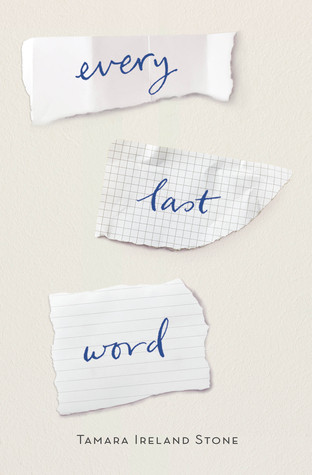
My Opinion: The only thing I hated about Every Last Word is that it doesn’t come out until June 16th, which means my current 7th graders do not have access to it. And I wish they did. I still told a few of them about this book and told them to come see me at the beginning of the year so they can read it. I know it will speak to them as it spoke to me.
Age Range: 6th and up. Slightly mature relationship but tactfully handled.
Summary:
Samantha McAllister looks just like the rest of the popular girls in her junior class. But hidden beneath the straightened hair and expertly applied makeup is a secret that her friends would never understand: Sam has Purely-Obsessional OCD and is consumed by a stream of dark thoughts and worries that she can’t turn off.
Second-guessing every move, thought, and word makes daily life a struggle, and it doesn’t help that her lifelong friends will turn toxic at the first sign of a wrong outfit, wrong lunch, or wrong crush. Yet Sam knows she’d be truly crazy to leave the protection of the most popular girls in school. So when Sam meets Caroline, she has to keep her new friend with a refreshing sense of humor and no style a secret, right up there with Sam’s weekly visits to her psychiatrist.
Caroline introduces Sam to Poet’s Corner, a hidden room and a tight-knit group of misfits who have been ignored by the school at large. Sam is drawn to them immediately, especially a guitar-playing guy with a talent for verse, and starts to discover a whole new side of herself. Slowly, she begins to feel more “normal” than she ever has as part of the popular crowd . . . until she finds a new reason to question her sanity and all she holds dear.

My Opinion: George is finally available August 25th and is a must add to any classroom, 4th grade and up. When we say we need diverse books, it is a book like this that we need to have in our classrooms.
Age Range: 4th and up.
Summary:
When people look at George, they think they see a boy. But she knows she’s not a boy. She knows she’s a girl.
George thinks she’ll have to keep this a secret forever. Then her teacher announces that their class play is going to be Charlotte’s Web. George really, really, REALLY wants to play Charlotte. But the teacher says she can’t even try out for the part . . . because she’s a boy.
With the help of her best friend, Kelly, George comes up with a plan. Not just so she can be Charlotte — but so everyone can know who she is, once and for all.

My Opinion: I have loved Rebecca Stead’s books since When You Reach Me and this one Goodbye Stranger is right up there. While this won’t be out until August 4th I already have it pre-ordered so I can book talk it the first week of school.
Age Range: 5th and up.
Summary:
Bridge is an accident survivor who’s wondering why she’s still alive. Emily has new curves and an almost-boyfriend who wants a certain kind of picture. Tabitha sees through everybody’s games–or so she tells the world. The three girls are best friends with one rule: No fighting. Can it get them through seventh grade?
This year everything is different for Sherm Russo as he gets to know Bridge Barsamian. What does it mean to fall for a girl–as a friend?
On Valentine’s Day, an unnamed high school girl struggles with a betrayal. How long can she hide in plain sight?
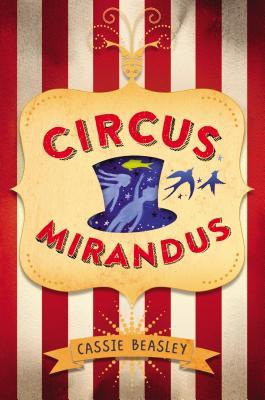
My Opinion: Along with Fish In A Tree, Circus Mirandus is a must-read book of the year. Amazing, fantastic, spellbinding, and any other gushy word I can think of. This is a modern day classic.
Age Range: 3rd and up if high reader.
Summary:
Do you believe in magic?
Micah Tuttle does.
Even though his awful Great-Aunt Gertrudis doesn’t approve, Micah believes in the stories his dying Grandpa Ephraim tells him of the magical Circus Mirandus: the invisible tiger guarding the gates, the beautiful flying birdwoman, and the magician more powerful than any other—the Man Who Bends Light. Finally, Grandpa Ephraim offers proof. The Circus is real. And the Lightbender owes Ephraim a miracle. With his friend Jenny Mendoza in tow, Micah sets out to find the Circus and the man he believes will save his grandfather.
The only problem is, the Lightbender doesn’t want to keep his promise. And now it’s up to Micah to get the miracle he came for.

My Opinion: Bone Gap both kept me guessing and frustrated me. This tale it spun was confusing, yet magical ad I read it in one night. Sadly I chose to leave it at home because I felt it was a touch mature for most of my 7th graders.
Age Range: 8th and up or high school due to relationship things.
Summary:
Everyone knows Bone Gap is full of gaps—gaps to trip you up, gaps to slide through so you can disappear forever. So when young, beautiful Roza went missing, the people of Bone Gap weren’t surprised. After all, it wasn’t the first time that someone had slipped away and left Finn and Sean O’Sullivan on their own. Just a few years before, their mother had high-tailed it to Oregon for a brand new guy, a brand new life. That’s just how things go, the people said. Who are you going to blame?
Finn knows that’s not what happened with Roza. He knows she was kidnapped, ripped from the cornfields by a dangerous man whose face he cannot remember. But the searches turned up nothing, and no one believes him anymore. Not even Sean, who has more reason to find Roza than anyone, and every reason to blame Finn for letting her go.
As we follow the stories of Finn, Roza, and the people of Bone Gap—their melancholy pasts, their terrifying presents, their uncertain futures—acclaimed author Laura Ruby weaves a heartbreaking tale of love and loss, magic and mystery, regret and forgiveness—a story about how the face the world sees is never the sum of who we are.

My Opinion: Jo Knowles is one of the few writers where I have all of their books. I loved the story-telling of Read Between the Lines , and I loved searching for clues as to how it would end up.
Age Range: 6th and up depending on the maturity of the reader.
Summary:
Thanks to a bully in gym class, unpopular Nate suffers a broken finger—the middle one, splinted to flip off the world. It won’t be the last time a middle finger is raised on this day. Dreamer Claire envisions herself sitting in an artsy café, filling a journal, but fate has other plans. One cheerleader dates a closeted basketball star; another questions just how, as a “big girl,” she fits in. A group of boys scam drivers for beer money without remorse—or so it seems. Over the course of a single day, these voices and others speak loud and clear about the complex dance that is life in a small town. They resonate in a gritty and unflinching portrayal of a day like any other, with ordinary traumas, heartbreak, and revenge. But on any given day, the line where presentation and perception meet is a tenuous one, so hard to discern. Unless, of course, one looks a little closer—and reads between the lines.

My Opinion: This is the epitome of page turner to me, quick, fast, and easy to digest, April Henry knows how to crank them out, leaving us at the edge of our seats. All of her books look very worn this year but The Body in the Woods was probably one of the most read. Best part is that this is the first book of a series.
Age Range: 5th grade and up but it does have a killer in it.
Summary:
Alexis, Nick, and Ruby have very different backgrounds: Alexis has spent her life covering for her mom’s mental illness, Nick’s bravado hides his fear of not being good enough, and Ruby just wants to pursue her eccentric interests in a world that doesn’t understand her. When the three teens join Portland County Sheriff’s Search and Rescue, they are teamed up to search for a autistic man lost in the woods. What they find instead is a dead body. In a friendship that will be forged in danger, fear, and courage, the three team up to find the girl’s killer—before he can strike one of their own.
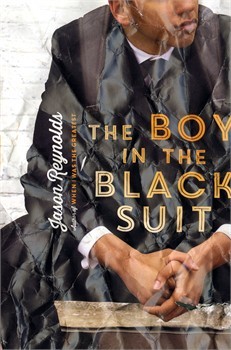
My Opinion: I loved how much The Boy in the Black Suit with its moving story spoke to so many different students and myself. Jason Reynolds is a master storyteller and draws the reader in with this simple, yet compelling story.
Age Range: 5th and up.
Summary:
Just when seventeen-year-old Matt thinks he can’t handle one more piece of terrible news, he meets a girl who’s dealt with a lot more—and who just might be able to clue him in on how to rise up when life keeps knocking him down—in this wry, gritty novel from the author of When I Was the Greatest.
Matt wears a black suit every day. No, not because his mom died—although she did, and it sucks. But he wears the suit for his gig at the local funeral home, which pays way better than the Cluck Bucket, and he needs the income since his dad can’t handle the bills (or anything, really) on his own. So while Dad’s snagging bottles of whiskey, Matt’s snagging fifteen bucks an hour. Not bad. But everything else? Not good. Then Matt meets Lovey. She’s got a crazy name, and she’s been through more crazy than he can imagine. Yet Lovey never cries. She’s tough. Really tough. Tough in the way Matt wishes he could be. Which is maybe why he’s drawn to her, and definitely why he can’t seem to shake her. Because there’s nothing more hopeful than finding a person who understands your loneliness—and who can maybe even help take it away.

My Opinion: I was surprised t how much I liked Red Butterfly, I loved the twists and turns and found myself personally invested in it. With its poetic narration of an unbelievable story, you have to just read one more page to see what happens.
Age Range: 4th and up.
Summary:
Kara never met her birth mother. Abandoned as an infant, she was taken in by an elderly American woman living in China. Now eleven, Kara spends most of her time in their apartment, wondering why she and Mama cannot leave the city of Tianjin and go live with Daddy in Montana. Mama tells Kara to be content with what she has … but what if Kara secretly wants more?

My Opinion: The stark beauty of the words of Locomotion left me silent for a long time. I used several excerpts with students as well, which lead to them reading the book.
Age Range: 5th and up.
Summary:
When Lonnie Collins Motion “Locomotion” was seven years old, his life changed forever. Now he’s eleven, and his life is about to change again. His teacher, Ms. Marcus, is showing him ways to put his jumbled feelings on paper. And suddenly, Lonnie has a whole new way to tell the world about his life, his friends, his little sister Lili, and even his foster mom, Miss Edna, who started out crabby but isn’t so bad after all. Jacqueline Woodson’s novel-in-poems is humorous, heartbreaking . . . a triumph.

My Opinion: Incredible book that leaves you turning every page so you can see how it ends. This was passed around my classroom quite a bit, never quite settling in on our shelves. We Were Liars was a must read for many students and teachers this year.
Age Range: 7th and up due to mature language and subjects.
Summary:
A beautiful and distinguished family.
A private island.
A brilliant, damaged girl; a passionate, political boy.
A group of four friends—the Liars—whose friendship turns destructive.
A revolution. An accident. A secret.
Lies upon lies.
True love.
The truth.
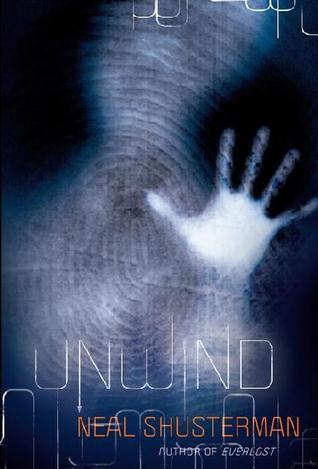
My Opinion: A fantastic sci-fi series which I cannot wait to continue reading. I used Unwind for a book club group as well and they loved it.
Age Range: 6th and up.
Summary:
The Second Civil War was fought over reproductive rights. The chilling resolution: Life is inviolable from the moment of conception until age thirteen. Between the ages of thirteen and eighteen, however, parents can have their child “unwound,” whereby all of the child’s organs are transplanted into different donors, so life doesn’t technically end. Connor is too difficult for his parents to control. Risa, a ward of the state, is not enough to be kept alive. And Lev is a tithe, a child conceived and raised to be unwound. Together, they may have a chance to escape and to survive.
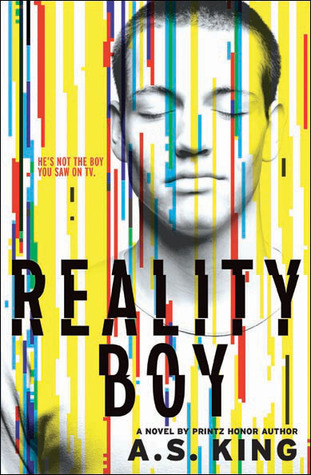
My Opinion: I loved Reality Boy for its brutal betrayal of what being angry can mean for your life. This book resonated with me and a few males students because they could relate to Gerald’s life.
Age Range: 7th and up – it has mature language and mature subject matter.
Summary:
Gerald Faust knows exactly when he started feeling angry: the day his mother invited a reality television crew into his five-year-old life. Twelve years later, he’s still haunted by his rage-filled youth—which the entire world got to watch from every imaginable angle—and his anger issues have resulted in violent outbursts, zero friends, and clueless adults dumping him in the special education room at school.
Nothing is ever going to change. No one cares that he’s tried to learn to control himself, and the girl he likes has no idea who he really is. Everyone’s just waiting for him to snap…and he’s starting to feel dangerously close to doing just that.
Filed under: being me, global read aloud, Reading


June 9, 2015
To All the Teachers Who Cared This Year

5 days into kindergarten, my oldest daughter declared that she hated school. With all of the anger she could muster, which was remarkably quite a bit, she stomped her foot, scrunched up her face and told me that school was not for her after all because her teacher hated her and she was done. I chalked it up to her being tired. When on the 6th day, and the 7th, and the 8th, she told me that she still didn’t like school, and on the 9th she told me she had a stomach ache, I knew we had a problem.
It wasn’t that I thought that her school was bad. It was not that her teacher did hate her but in her mind, her reality, this was the truth she lived. And once that idea had set in, she was done. So 3 weeks into the school year of her very first year we open enrolled her in my district and Thea started kindergarten once again. I swear I have held my breath since then. Yesterday, she proudly showed me her kindergarten memory book and my breath caught for a moment when I saw what she had written. Under her most favorite thing she had written “Going to school.” And then I knew that I had to give thanks.
So to the teacher that loved my little girl so much that she cried on the night before the last day; thank you. I know how much you tried, I know much you cared. I know how many hours you worked, and how much time you spent thinking about all of those kids you taught. I know that there were days where I am sure you wanted to pull your hair out, we all have those days, but I also know that Thea told me that you were always happy. That no matter what you were happy to see her and she loved you for it.
You may not know, but that smile you put on your face, those little conversations that you had, the stories you told of your own adventures; those are what she told us about every single day. Those times you got silly, those times you held them to high expectations, she told us about that too. Every day a new story, every day a new memory. And so when she told me that she didn’t want any other teacher ever again, I knew that I would never have enough words to tell you how grateful we are. She hated school. You changed that. She faked stomach aches, threw fits, and cried those big fat tears, but you changed that. That is why great teachers matter. That is why people like you are so important for all of our kids.
So to all you teachers who cared this year. From this parent, who happens to be a fellow teacher, thank you. Thank you for putting in the time. Thank you for caring. Thank you for dedicating all of your emotional energy because you cared so very deeply for all of our kids. Thank you for inventing, for making, for creating. For giving students voices. For not giving up. For hugging. For listening and for seeing all of the kids for who they are. For giving hope, and for giving consequences. For making kids believe that they could achieve, even when the world was against them.
They say it takes a village to raise a kid, but honestly, sometimes it just takes one person. A person who sees your crazy amazing kid exactly for who they are and doesn’t think that something is wrong with them but instead tells them to be proud of who they are. So to Mrs. Huenink; the world needs more teachers like you so that more kids like mine can feel that they matter and that school is actually a place for them. Thank you.
I am a passionate teacher in Oregon, Wisconsin, USA but originally from Denmark, who has taught 4th, 5th, and 7th grade. Proud techy geek, and mass consumer of incredible books. Creator of the Global Read Aloud Project, Co-founder of EdCamp MadWI, and believer in all children. The second edition of my first book “Passionate Learners – How to Engage and Empower Your Students” // is available for pre-order now. Second book “Empowered Schools, Empowered Students – Creating Connected and Invested Learners” is out now from Corwin Press. Join our Passionate Learners community on Facebook and follow me on Twitter@PernilleRipp.
Filed under: aha moment, being a teacher, being me, end of year, teachers


June 8, 2015
A Must Read Book for Educators
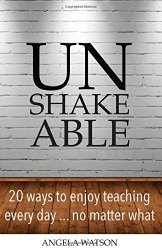 Several years ago, I read the book Awakened by Angela Watson and her words changed who I was as a teacher (and person). I did not know Angela much at that time, I admired her from afar, but was so profoundly moved by how her book helped me move away from negative thoughts, that I contacted her to express my deep gratitude. A few years later, I am lucky to call Angela a mentor and inspiration. I still keep my Awakened mindset and recommend the book to any teachers I meet. Well, Angela has done it again with her new book Unshakeable – 20 Ways to Enjoy Teaching Every Day…No Matter What.
Several years ago, I read the book Awakened by Angela Watson and her words changed who I was as a teacher (and person). I did not know Angela much at that time, I admired her from afar, but was so profoundly moved by how her book helped me move away from negative thoughts, that I contacted her to express my deep gratitude. A few years later, I am lucky to call Angela a mentor and inspiration. I still keep my Awakened mindset and recommend the book to any teachers I meet. Well, Angela has done it again with her new book Unshakeable – 20 Ways to Enjoy Teaching Every Day…No Matter What.
Even as a somewhat veteran teacher, I found so many great ideas within the pages of this book. Angela is a no nonsense writer who crams inspiration into every single page. She isn’t just trying to inspire us to change, she is giving us ideas of how to do it, and the best part is that many of the ideas are so ingeniously simple, yet powerful, that I implemented some on the very first day of reading. From redefining my vision to many minor changes I can do to re-energize myself and my classroom, I am so grateful I got to read this book. So while I do not use this blog to recommend many books, I typically do that on another blog, I knew that I had to highlight this book to all of you who follow on here.
So if you know a new teacher who needs some inspiration. If you know a fellow teacher who could use some great new ideas. If you know that this is the summer you need to be inspired and re-energized; read this book. And then recommend it to others. You will be glad you did.
From Amazon:
Don’t wait for teaching to become fun again: plan for it! Unshakeable is a collection of inspiring mindset shifts and practical, teacher-tested ideas for getting more satisfaction from your job. It’s an approach that guides you to find your inner drive and intrinsic motivation which no one can take away. Unshakeable will help you incorporate a love of life into your teaching, and a love of teaching into your life. Learn how to tap into what makes your work inherently rewarding and enjoy teaching every day…no matter what.
Filed under: being a teacher, being me, inspiration, review






